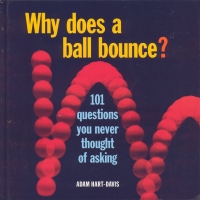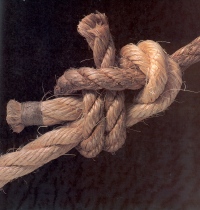| ________________
CM . . .
. Volume XII Number 16 . . . .April 14, 2006
excerpt:
Science happens all around us. With basic knowledge of scientific principles, we can understand much of what our senses tell us about the world of plants, animals, weather and technology. Mysteries abound, however. How to explain why bubbles are coloured, how radar guns work, what exactly is slug slime? This book is a collection of such diverse puzzles inspired by the author's own photographs that prompted him to ask questions. Not all the objects show serious science, but they arouse curiosity nonetheless. Using his experience as a science book editor, photographer and writer, Hart-Davis has dug, researched, queried experts and added some speculation to come up with informative, entertaining, and sometimes amusing articles.
Is this a book of photographic art, or science fact? You can browse through it for both of these elements. Some of the science gets a bit complex for young readers and is reminiscent of a high school science text. The book makes an interesting conversation piece and may be useful as a catalyst for research. Recommended. Living in BC, Gillian Richardson is a freelance writer and former teacher-librarian.
To comment
on this title or this review, send mail to cm@umanitoba.ca.
Copyright © the Manitoba Library Association. Reproduction for personal
use is permitted only if this copyright notice is maintained. Any
other reproduction is prohibited without permission.
NEXT REVIEW |
TABLE OF CONTENTS FOR THIS ISSUE
- April 14, 2006.
AUTHORS |
TITLES |
MEDIA REVIEWS |
PROFILES |
BACK ISSUES |
SEARCH |
CMARCHIVE |
HOME |

 Along with a full page photo (many extreme closeups such as you'll see in those 'What is it?' magazine quizzes) there's a page to discuss the question it evoked. Extra bits of trivia — Did You Know? — and sometimes a Challenge are included. Did you know, for example, that if you shine a bright light into one eye, both pupils contract? The Challenges are teasers to encourage further experimentation; some pose puzzles that go unanswered. The author has added several pages of technical details to explain how he achieved a number of the photos.
Along with a full page photo (many extreme closeups such as you'll see in those 'What is it?' magazine quizzes) there's a page to discuss the question it evoked. Extra bits of trivia — Did You Know? — and sometimes a Challenge are included. Did you know, for example, that if you shine a bright light into one eye, both pupils contract? The Challenges are teasers to encourage further experimentation; some pose puzzles that go unanswered. The author has added several pages of technical details to explain how he achieved a number of the photos.